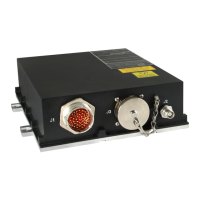INSTALLATION MANUAL
CMA-5024 GLSSU
This document includes Proprietary Information and shall not be reproduced or communicated to third party
without prior written permission by CMC Electronics Inc.
Page 1
November 21, 2008
SECTION I
DESCRIPTION AND OPERATION
1. PURPOSE OF MANUAL
The purpose of this manual is to provide installation instructions for the CMA-5024 GPS Landing System
(GLS) Sensor Unit, thereafter "GLSSU".
This manual covers the following topics: Description, operation, installation, checkout, removal and
replacement of Line Replaceable Unit (LRU) equipment.
It is intended for use by aircraft technicians, mechanics and flight line personnel responsible for the
installation of electronic equipment aboard aircrafts and its maintenance at the flight line level. It can also
serve to the system integrator for designing and testing the aircraft installation.
2. PURPOSE OF EQUIPMENT
A. General
The GLSSU performs the sensor and approach guidance functions of an SBAS-based Area Navigation
(RNAV) aircraft system to be used for the en route, terminal area and approach phases of flight. The
GLSSU satisfies the requirements for the following instrument approach procedures: Lateral Navigation
(LNAV), Lateral Navigation/Vertical Navigation (LNAV/VNAV), Localizer Performance without vertical
guidance (LP), and Localizer Performance with vertical guidance (LPV). The GLSSU is compliant with
RTCA/DO-229D, TSO-C145b Class Beta-3 and TSO-C146b Class Delta-4.
Beta functional class equipment consists of a GPS/SBAS sensor that determines position (with integrity)
and provides position and integrity data to an integrated navigation system (e.g., flight management
system, multi-sensor navigation system). This equipment also provides integrity in the absence of the
SBAS signal through the use of Fault Detection and Exclusion (FDE). Since it is purely a sensor, it does
not provide direct pilot interfaces.
Delta functional class equipment consists of both the GPS/SBAS position sensor (defined by Class
Beta) and a navigation function, so that the equipment provides path deviations relative to a selected
final approach path. Class Delta does not provide an RNAV capability and is not required to provide a
FAS database or direct pilot controls/displays.
There are 4 operational classes defined by RTCA/DO-229D as follows:
Class 1: Equipment that supports oceanic and domestic en route, terminal, approach (LNAV), and
departure operation.
Class 2: Equipment that supports oceanic and domestic en route, terminal, approach (LNAV,
LNAV/VNAV), and departure operation. It therefore includes class 1 operations.
Class 3: Equipment that supports oceanic and domestic en route, terminal, approach (LNAV,
LNAV/VNAV, LP, LPV), and departure operation. It therefore includes class 1 and 2 operations.
Class 4: Equipment that supports only the final approach segment operation. This class of equipment is
intended to serve as an ILS alternative that supports LP and LPV operations with degradation (fail-
down) from LPV to lateral only (LNAV). Class 4 equipment is only applicable to functional Class Delta.
The document reference is online, please check the correspondence between the online documentation and the printed version.

